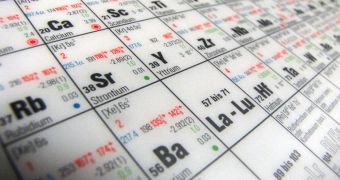Dmitri Mendeleev's Periodic Table of Chemical Elements has just been augmented with two new entries – elements 114 and 116. An international commission of scientists, comprised mostly of physicists and chemists, agreed to include the ultra-heavy chemicals in the Table.
Copernicium and roentgenium, at 285 and 272 atomic mass units, respectively, were the previous record-holders for the world's heaviest chemicals. But now, their place has been taken by elements 114 and 116, at 289 and 292 atomic mass units, respectively.
One of the reasons why the international scientific community took its time to introduce the new elements into the Table is the fact that they are extremely short-lived. They can last for about a second, before they are destroyed, due to their inherent stability.
The two elements are radioactive, experts say. When left alone, element 116 will decay into element 114, which will itself decay into copernicium (element 112). The decay process is accompanied by the release of alpha particles.
The International Union of Pure and Applied Chemistry (IUPAC) says that only 75 copernicium atoms have ever been identified. The element is purely synthetic, and can only be produced in the laboratory.
The first, single atom of rapidly decaying element 114 was produced back in 1999, when a team of Russian physicists bombarded plutonium-244 targets with calcium-48 atoms. The resulting shower of particles contained one of the new atoms.
One year later, in 2000, element 116 was also found. Over the following years, researchers around the world gathered evidence to prove that the detection of these ultra-heavy atoms was not some sort of statistical fluke in the results.
Eventually, IUPAC and the International Union of Pure and Applied Physics (IUPAP) declared themselves satisfied, and awarded to two elements their official status on June 1, 2011.
Scientists have yet to decide on names for the two elements, which are temporarily called ununquadium (114) and ununhexium (116). Experts with the Joint Institute for Nuclear Research in Dubna, Russia, who found the elements, want to name 114 flerovium, and 116 moscovium. The former could get its name from Soviet nuclear physicist Georgy Flyorov, who discovered seaborgium and bohrium.
He is also responsible for the onset of the Soviet nuclear program. The physicist wrote to Stalin back in 1942, indicating that the lack of scientific talk coming from the United States in the field of nuclear physics could be a sign that something was brewing. Three years later, he was proven right.
IUPAC and IUPAP representatives were also presented with early evidence as to the existence of elements 113, 115 and 118, provisionally named ununtrium, ununpentium and ununoctium.
The committee decided that the preliminary results were encouraging, but urged the scientific community to conduct more verification work. The efforts are direct at ensuring that the three new elements are not statistical flukes themselves, Wired reports.

 14 DAY TRIAL //
14 DAY TRIAL //